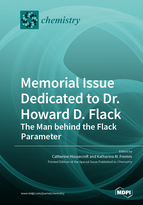Memorial Issue Dedicated to Dr. Howard D. Flack: The Man behind the Flack Parameter
A special issue of Chemistry (ISSN 2624-8549). This special issue belongs to the section "Crystallography".
Deadline for manuscript submissions: closed (31 March 2021) | Viewed by 58923
Special Issue Editors
Interests: light harvesting using inorganic coordination complexes as dyes in dye-sensitized solar cells (DSCs); development of emissive complexes for application in light-emitting electrochemical cells (LECs); water splitting and water oxidation catalysts; functional coordination polymers and networks; chemical education
Special Issues, Collections and Topics in MDPI journals
Interests: crystallography; antimicrobial compounds; bioinorganic chemistry of silver; nanomaterials; coordination compounds; batteries
Special Issues, Collections and Topics in MDPI journals
Special Issue Information
Dear Colleagues,
This Special Issue of Chemistry is dedicated to Dr. Howard D. Flack (1943–2017), a renowned crystallographer who transformed the way in which, by using single crystal X-ray diffraction, we are able to determine the absolute structure of a crystalline material and thereby determine the absolute configuration of molecular species within material. Any of us who routinely use cifs are familiar with the 'Flack Parameter', and younger generations take it for granted. Not everyone realizes that this is a relatively recent implementation (‘’On Enantiomorph-Polarity Estimation’’, H.D. Flack, Acta Crystallogr. 1983, A39, 876, doi:10.1107/S0108767383001762).
Howard Flack studied at the University of Cambridge, UK and moved to take up the position of Maître-Assistant in the Laboratoire de Cristallographie at the University of Geneva, Switzerland in 1972. He remained in Geneva working as a crystallographer for his entire career and contributed his knowledge, enthusiasm, and encouragement to the establishment of crystallographic facilities at other Swiss Universities. His invaluable computational and scholarly contributions to single-crystal X-ray diffraction have left an extraordinary mark on the field, and this Special Issue provides a timely opportunity to pay tribute to him.
Prof. Dr. Catherine Housecroft
Prof. Dr. Katharina Fromm
Guest Editors
Manuscript Submission Information
Manuscripts should be submitted online at www.mdpi.com by registering and logging in to this website. Once you are registered, click here to go to the submission form. Manuscripts can be submitted until the deadline. All submissions that pass pre-check are peer-reviewed. Accepted papers will be published continuously in the journal (as soon as accepted) and will be listed together on the special issue website. Research articles, review articles as well as short communications are invited. For planned papers, a title and short abstract (about 100 words) can be sent to the Editorial Office for announcement on this website.
Submitted manuscripts should not have been published previously, nor be under consideration for publication elsewhere (except conference proceedings papers). All manuscripts are thoroughly refereed through a single-blind peer-review process. A guide for authors and other relevant information for submission of manuscripts is available on the Instructions for Authors page. Chemistry is an international peer-reviewed open access semimonthly journal published by MDPI.
Please visit the Instructions for Authors page before submitting a manuscript. The Article Processing Charge (APC) for publication in this open access journal is 1800 CHF (Swiss Francs). Submitted papers should be well formatted and use good English. Authors may use MDPI's English editing service prior to publication or during author revisions.







